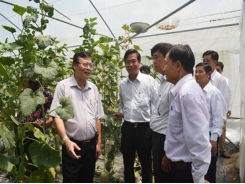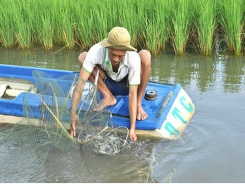Fishery enterprises expand the domestic market

In addition to the development of exports, many domestic fishery companies have also focused on developing the domestic market, but there are many difficulties.
Illustrated photo
Being the main exporter but still ignores the domestic market
Mr. Nguyen Van Dao, General Director of Go Dang Joint Stock Company:
Pangasius fishery enterprises “are particularly interested in exporting, ignore the domestic market” as more than 95% of products is for export. Value added products of pangasius has more than 50 items, including for exports, while the domestic only 6-7 items.
As the key export items, Vietnamese pangasius export to more than 140 countries, but facing many difficulties in inland. At the workshop on “Developing domestic pangasius market” at the weekend, Ms. Ly Thi Thanh Loan, Member of Executive Committee of Vietnam Pangasius Association said that, the pangasius industry almost has left the domestic market. The reason is that enterprises have not paid much attention to the distribution, market segmentation and consumer tastes. In addition, the chain linking the processing, distribution, consumption is still ambiguous. In the fisheries industry, the previous stage output is the next input stage. Only if there is a sustainable linkage, the market for pangasius develops well.
With ten-year-experience in the pangasius industry, Ms. Truong Thi Le Khanh, Chairman of Vinh Hoan Corporation, said that the company is specialized in processing pangasius products, Vinh Hoan needs a plan for processing according to the market demand. Therefore, it must survey the market to adapt to reduce production costs. About the market survey, market information both in domestic and export, enterprises need the support of management agencies, business associations to develop business plans and get the right direction... Currently, in addition to pangasius fillet, Vinh Hoan is also focusing on producing many products from pangasius products for domestic market and export.
Ms. Ngo Thi Thuc, Deputy Director of Regional Sub-department 1 - Department of Agro-product Processing and Market asserted that, the unit is very interested in the domestic pangasius market, each year there are policies, support programs such as fairs, exhibitions to create a connection environment, trade between enterprises, however, the efficiency is not high.
Along with Pangasius, the second most important export item is shrimps that also presents in supermarkets in the country. Minh Phu is the number one seafood company in Vietnam and the leading in the world, with three product lines: fresh, steamed and value added products. However, this company still focuses on the export market. Minh Phu's products are exported to more than 50 countries and territories, with turnover of more than 10,000 billion VND per year.
Facing difficulties to put products into the supermarket
In addition to the export development, many seafood companies in the country have also focused on developing the domestic market, the consumption of domestic fisheries products is more than 22,000 billion VND (equivalent to $US 1 billion), this is not small figure. In particular, the average growth rate in terms of value is higher than the average growth in output, which shows that the product quality as well as added value of the product is improving, but there are still many difficulties.
According to the VASEP, many seafood enterprises in Vietnam are facing major obstacles related to the maximum performance required limit (MPRL) of chemicals and antibiotics prohibited in food products. With different understandings among regulators, supermarkets and suppliers on some regulations, many seafood products are difficult to enter into this domestic distribution channel.
Under the provisions of Decision No. 2005/34 EC dated January 11, 2005 of the European ban, if the parsing of the consignment is lower than the minimum parsing performance, the food will not be banned from use and are still allowed to import into the EU.
However, Vietnam has only issued maximum residue levels (MRLs) for limited chemicals and antibiotics, but it has not issued a regulation on MPRL for prohibited indicators. Thus, supermarkets still do not accept consignments of foodstuffs containing banned chemicals, antibiotics, although residues of these substances in the product are very low, below the MPRL standards of EU regulation that does not affect the health of the consumer.
Along with that, enterprises also encountered many difficulties when seafood items put into supermarkets that are demanded too high discount by some units, making enterprises frustrated.
According to experts, when integrating more deeply, Vietnamese enterprises will be more difficult to compete with foreign companies in the home market. Foreign companies have quickly made use of the available resources and cheap labor of Vietnam along with the advantages in scale, technology and finance to invest in building factories and production facilities in Vietnam. Therefore, in order to develop the domestic market, enterprises need to link production chains, consumption, product traceability; create trust with consumers in the country, increase value for products...
By the end of November, total seafood export turnover reached $US 8 billion, increasing nearly 5% compared to the same period in the last year. Of which, the two main exports are shrimp and pangasius have increased and decreased oppositionally. While the export of pangasius maintained a good growth, shrimps fell sharply. Shrimp exports reached nearly $US 3.3 billion, down by 7% compared to the same period in the last year.
The pangasius export maintained a positive growth, bringing the results of export in 11 months to over $US 2 billion. The exports of tuna, octopus and other seafood tends to increase at the end of the year. With the current growth momentum, the VASEP expects seafood exports in 2018 to reach $US 8.8 billion, increasing by 6% compared to 2017.
Related news
Tools

Phối trộn thức ăn chăn nuôi

Pha dung dịch thủy canh

Định mức cho tôm ăn

Phối trộn phân bón NPK

Xác định tỷ lệ tôm sống

Chuyển đổi đơn vị phân bón

Xác định công suất sục khí

Chuyển đổi đơn vị tôm

Tính diện tích nhà kính

Tính thể tích ao




 Vietnam’s mushroom cultivation declines due to poor technology…
Vietnam’s mushroom cultivation declines due to poor technology…  Cà Mau looks to VietGAP standards
Cà Mau looks to VietGAP standards